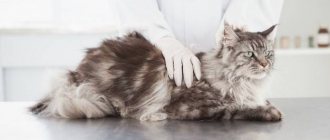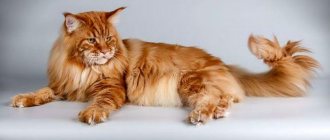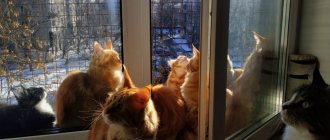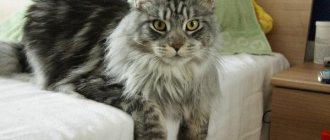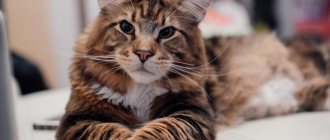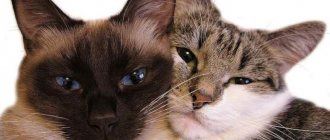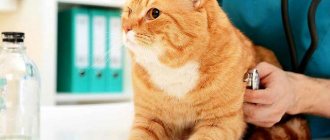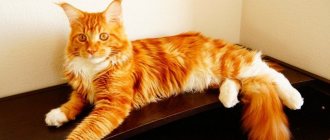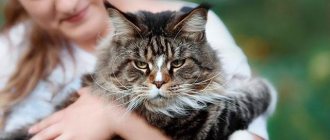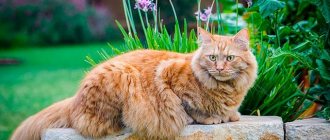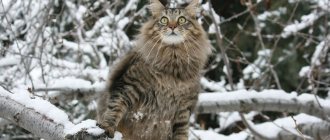Cat owners often notice purulent discharge from the eyes of their pets. Cat eyes are a vulnerable organ, and eye diseases in cats are common. If action is not taken in time, a small problem can result in loss of vision. How to determine why a cat’s eyes are festering, whether you can help your pet yourself and how to treat the discharge - more on this below.
Main symptoms of eye disease in cats
In healthy cats, a small amount of translucent discharge, sometimes brown or grayish, occasionally forms in the eyes. Such rare and isolated tearing should not cause cause for alarm in the owner. But if the discharge becomes profuse, purulent, observed daily, the eye festers with blood, the owner needs to worry and understand that the cat needs help. The disease will not disappear on its own, so such signs cannot be ignored.
Serious problems with the organs of vision are indicated by various alarming symptoms, in addition to discharge from the eyes. The owner must be alert to the following external signs and behavior of the pet:
- eyes become red or cloudy and swollen;
- the cornea becomes covered with a white film or a cataract appears;
- the cat constantly rubs his eyelids with his paw;
- often blinks constantly;
- the fur around sore eyes becomes brown and matted;
- a sticky brown crust of pus appears on the eyes, preventing the eye from fully opening;
- strabismus: often observed in early glaucoma;
- photophobia and increased sensitivity to light;
- pain: the pet begins to meow and howl when it touches its eyelids with its paw;
- aggressiveness, desire to hide in the dark, avoidance of contacts;
- loss of appetite;
- sometimes increased body temperature.
The most alarming symptoms to pay attention to are lack of appetite and increased body temperature. Prolonged persistent fever and lethargy are characteristic of viral and acute infectious diseases. This may additionally be indicated by vomiting and intestinal upset. If your cat has snot running and eyes that are purulent, it is quite possible that the animal has a runny nose. In this case, you need to pay attention to the nature of the discharge: clear snot indicates that the disease will soon pass, and yellow-green purulent discharge from the nose should cause alarm and become a reason to contact a veterinarian.
Maine Coon sheds a lot
It happens that your cat, regardless of its breed, sheds more than usual. Having experience of keeping 3 cheerful Maine Coons for 5 years, I can say that shedding once a year is a mandatory procedure for each of my animals.
The molting of a coon, of course, looks impressive: feathers are pouring out from the lush tail in different directions, not a trace remains of the mane, the sides are losing weight before our eyes, rapidly losing fullness due to the decreasing volume of fur, and this fur itself is no longer just in the soup and bed, but even in a freshly opened carton of milk.
However, it happens that the coon sheds not seasonally, but somehow suddenly. It seems like it’s time for the shedding to end, but the fur is still flying, the nerves are getting worse, the cat looks like a runt.
Causes of heavy shedding in Maine Coons
Inappropriate nutrition . Not wrong, but not appropriate. This may be the best and most expensive food, the most selected meat and the coolest vitamins, but this diet is not suitable for your animal, which is reflected in the coat. Well, to those who devour whiskey and other things - my ardent greetings. Eat it yourself and let's see how you shed;
Incorrect care . Too frequent or infrequent washing, washing with shampoos for 100 rubles, combing with a slicker brush, tangles not removed in time, refusal of conditioner when the coat is apparently dry and statically sparkling - the most obvious reasons for peeling;
Disease . There are many health problems that affect the coat, from digestive problems to systemic diseases.
Source
Causes of suppuration and tearing
Purulent discharge from the eyes of cats can be caused by various factors: infections, allergies, injuries or eye diseases. Below are all the possible reasons.
- Conjunctivitis. This disease, caused by fungi, bacteria and viruses, is the most common cause of purulent eyes in cats. The pus may be yellow, green, or mixed with blood. The initial manifestations of conjunctivitis are watery eyes. Sometimes purulent conjunctivitis manifests itself as a symptom of various diseases of the animal’s internal organs: feline mycoplasmosis, chlamydia, bordetellosis, calcivirus infection. When a cat’s eyes fester and it sneezes, this is most likely the manifestation of the disease rhinotracheitis, or in other words, cat flu.
- Keratitis is inflammation of the cornea of the eye. This disease can occur as a result of injuries, burns, and physiological pathologies.
- Blepharitis is an inflammatory disease of the eyelids, which also develops after injuries, burns due to exposure to high temperatures, and chemicals.
- Injuries are mechanical damage to the eye tissues of varying degrees of severity. The eye can become inflamed as a result of games, fights with other animals, accidents, blows from branches, unsuccessful jumps, sand and dust.
- Contact with a foreign body on the cornea or conjunctiva, for example, a speck or small insect, a thorn. In this case, upon examination, an opaque area will be noticeable on the surface of the cornea.
- Allergic reactions. The mucous membrane of a cat's eyes is quite sensitive to allergens: perfume, pollen, house dust, cigarette smoke, and medications. Allergy itself does not cause pus, it only inflames the eyes, but with reduced immunity, the eye tissues are easily infected with bacteria, causing suppuration.
- Invasive diseases - worms and fleas in cats.
- Congenital eye pathologies: a double row of eyelashes, a dense lower eyelid or the shape of the muzzle, such as in Persians.
- Other, less common causes of eye suppuration are an unbalanced diet, lack of vitamin A and poor heredity.
Please note: if one eye of a cat is festering, then most likely the cause is injury or a foreign object. If both eyes fester, then most likely there is an infectious inflammation.
Diseases of the cardiovascular system
Hypertrophic cardiomyopathy is a Maine Coon disease that is inherited. The disease manifests itself in the form of hardening of the heart muscle, which leads to death. Symptoms of the disease include shortness of breath, the cat sleeps more than usual, does not show activity, moves sluggishly, and reluctantly.
Remember! Sometimes symptoms of the disease do not appear. The animal looks cheerful and absolutely healthy. The condition worsens sharply, and the Maine Coon dies!
If detected early, hypertrophic cardiomyopathy is treatable.
Types of discharge from the eyes
For a more accurate diagnosis, the owner needs to determine the nature of the discharge from the eyes: this will help distinguish dangerous eye diseases from less serious ones. The type of discharge will also help determine the involvement of pathogenic microflora in inflammatory phenomena.
The following types of discharge from a cat's eyes are distinguished:
| Type of discharge | Consistency | Possible reasons |
| Serous | Watery discharge of yellow, pink shades | The presence of an allergic reaction, including to chemicals or cigarette smoke or a viral infection |
| Mucous | Light viscous discharge without odor of protein structure | Chronic influence of various allergens, pathological conditions of the cornea, tear ducts |
| Purulent | Thick pus with a characteristic odor ranging from dark yellow to green | Bacterial, fungal infections |
Serous discharge may indicate the initial stage of development of pathologies of the visual organs. Often serous discharges turn into mucous discharges, and mucous discharges develop into mucopurulent discharges.
Diagnosis of diseases in cats
First, you need to carefully examine it, evaluate its appearance and condition: it is quite possible to make a reliable diagnosis at home. The data obtained will be needed for the doctor to make an accurate diagnosis and prescribe treatment.
At the clinic, veterinarians use the following basic diagnostic methods:
- analysis of the flushing of discharge from the eye membranes by inoculating a smear on nutrient media: this is how specific pathogens of the disease are identified;
- instillation of sodium fluorescein - a special pigment - into the conjunctival sac and subsequent viewing of the condition of the cornea through the light of a slit lamp: all defects, ulcers, wounds and even microorganisms are highlighted;
- biomicroscopy of the anterior zone of the eye using a slit lamp;
- Shrimmer test for dry eye syndrome, which allows you to determine the volume of tear fluid using express strips;
- measurement of intraocular pressure - used to determine glaucoma, leading to blindness;
- examination of the retina, optic nerve, fundus examination;
- Ultrasound of the eyeball.
You should not diagnose the disease yourself. Special equipment in clinics makes it possible to establish an accurate diagnosis and provide timely treatment, preserving vision and eye organs.
How are cat eyes treated?
At the first alarming symptoms, the cat should be taken to the veterinarian. Complex treatment is prescribed only by a specialist after appropriate tests and diagnostic studies. Self-medication can sometimes lead to sad and sometimes even fatal consequences. But still, you will be able to provide first aid to your pet, and in the future you will be able to independently carry out the procedures prescribed by the veterinarian, so as not to take the animal to the clinic every time for procedures. If the disease is acute, intensive therapy can only be carried out in a hospital setting. Next, we will consider what treatment methods are used for purulent discharge.
Washing a cat's eyes
This method can be used as first aid for a sick pet. How to wipe and wash a cat's eyes:
- chamomile or St. John's wort solution;
- 0.02% furatsilin solution or solution 2 tab. furatsilin per 1 tbsp. water;
- boric acid solution: 2 teaspoons per 500 ml of warm boiled water.
It is better to carry out the procedure together or secure the cat by swaddling it with a sheet or diaper. Rinsing is carried out with a clean cotton pad, which is twisted into a tourniquet, dipped into the solution and squeezed into the eye. Dried crusts are carefully removed.
Putting drops into a cat's eyes
What is allowed to instill:
- drops with antibiotic and dexamethasone: Tobrazon, Levomycentin drops;
- antiviral drops: Actipol, Okoferon;
- Neoconjunctivitis drops;
- "Diamond Eyes";
- Albucid;
- Iris.
Floxal drops, used in the treatment of human eyes, have proven themselves well. Veterinarians note that human drops are suitable for cats, but only with the prescription of a veterinarian.
Eye drops are instilled into a cat after first immobilizing the animal and placing it on its side, swaddled or with the help of an assistant. At the same time, the head is raised and held with the muzzle up. Drops are pipetted onto the conjunctiva and cornea of the open eye.
Remember: drops will not help cure the underlying disease and are not a panacea, but they will help eliminate the acute symptoms of purulent eyes.
Placing medicinal ointment under the eyelid
After washing and instilling drops under the lower eyelid, it is recommended to put a medicinal ointment. For this, tetracycline ointment 1% is used. The lower eyelid is pulled back, the ointment is placed there with a spatula, after which the eyelid needs to be closed and massaged a little for better distribution of the medicine. It is recommended to preheat the tube of ointment.
A training video from a veterinarian on how to put ointment under a cat’s eyelid.
How to treat an eye injury
If a cat's eye is red, purulent and swollen, the pet most likely has an injury. It is unacceptable to treat the eyelids with brilliant green or iodine: this can cause a painful shock and provoke pathological changes in the eye. Even if you see that a thorn is stuck in an animal’s eye, do not rush to pull it out yourself. It is best to take the animal to the clinic: you cannot know how deeply the foreign body has entered the eye area and damaged the cornea.
Measures to prevent eye infections
Preventing eye diseases in cats is very important for maintaining health. First of all, it is necessary to monitor the diet and behavior of pets, and during walks to avoid injuries to the animal or places that are dangerous for injury. Minor injuries should be treated immediately. Long-haired cats are advised to regularly trim the hair around their eyes. Among the general recommendations, it is important to remember:
- regular helminthization;
- vaccinations;
- treatment for parasites;
- use of antiallergenic drugs.
It is recommended that small kittens wash their eyes every day, and take adult animals to a veterinarian for regular checkups.
Cat owners need to closely monitor the health of their pets, constantly take preventive measures to prevent eye diseases and regularly examine the animal and take it to the veterinarian. If purulent discharge from the eyes of a cat is detected, there is no need to self-medicate; it is best to provide first aid to your mustachioed friend and, if possible, take him to a veterinarian. This will help save your pet’s vision, health and, ultimately, his life.
Maine Coon: height measurements, description, photo
If you have come across a cat in your life whose size and character partly resembles a medium-sized dog, then do not be surprised; it is not a mutant. This is a Maine Coon cat!
Of the domesticated animals, representatives of the Maine Coon family are the largest of all known world cat breeds (see the largest breed of domestic cats). However, this does not deprive them of feline grace, elegance of movements, sophistication, moderate strength, love of games and truly friendly friendliness towards people. Maine Coons were bred in North America approximately a century and a half ago.
The genes of the descendants of May Coons allegedly contain the blood of two strange lovers - an ordinary cat and a female raccoon. The fact is that the tail of seals and Maine Coon cats visually resembles the tail of a raccoon (it is long and moderately fluffy, like a raccoon), and the common (mostly soft) character traits that are similar in these two genetically different animals are also notable. As an analogue to the name, Maine Coons are sometimes called the Maine Coon Cat.
However, there is a second legend about the appearance of this breed, and it is much more realistic than the first: Maine Coons are supposedly the fruit of love between the North American lynx and domestic tabby cats. It would seem that there is nothing surprising or implausible in this story - Maine Coons have tufts on their ears, and their dimensions are quite large compared to other domestic cat breeds.
But alas, such genetic crossing is absolutely impossible, as in the first case, since these animals have significant species differences. Therefore, these two legends of the origin of Maine Coons are nothing more than a romantic fiction. Scientists have proven that such crossing of species cannot produce offspring.
If we consider the real theory of the origin of the breed, then it turns out that everything is quite simple
Source
